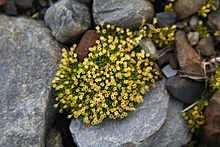Colobanthus quitensis
| Colobanthus quitensis | |
|---|---|
 | |
| Antarctic Pearlwort at St. Andrews Bay, South Georgia | |
| Scientific classification | |
| Kingdom: | Plantae |
| (unranked): | Angiosperms |
| (unranked): | Eudicots |
| (unranked): | Core eudicots |
| Order: | Caryophyllales |
| Family: | Caryophyllaceae |
| Genus: | Colobanthus |
| Species: | C. quitensis |
| Binomial name | |
| Colobanthus quitensis (Kunth) Bartl. | |
Colobanthus quitensis (Antarctic pearlwort) is one of two flowering plants found in the Antarctic region.[1] It occurs on the continental edge, as well as the South Orkney Islands and the South Shetland Islands. It has white flowers and grows about 5 cm (two inches) tall, with a cushion-like growth habit that gives it a moss-like appearance.
Due to a recent warming trend (see Global warming), more seeds are germinating, creating a large number of seedlings and plants. Reports indicate a fivefold increase in these plants, which have extended their ranges southward and cover more extensive areas, wherever found. This species extends south of 56° south.[2] Deschampsia antarctica (Antarctic hairgrass) is the only other native flowering plant in the region.[3]
Botanical synonyms include Sagina quitensis.
References
- ↑ Kozeretska, Iryna (2005), THE HERBARIUM OF ANTARCTIC VASCULAR PLANTS, National Taras Shevchenko University of Kyiv, retrieved 9 February 2015
- ↑ Parnikova, Ivan (2011), "Vascular Plants of the Maritime Antarctic: Origin and Adaptation", American Journal of Plant Sciences (Institute of Molecular Biology and Genetics of National Academy of Sciences of Ukraine) 2: 381–395, doi:10.4236/ajps.2011.23044
- ↑ Lichens, Antarctic; Significance, Vascular Plants: Their; Rudolph, E. D. (Apr 1965), "American Institute of Biological Sciences", BioScience (American Institute of Biological Sciences) 15 (4): 285–287, doi:10.2307/1293425, JSTOR 1293425